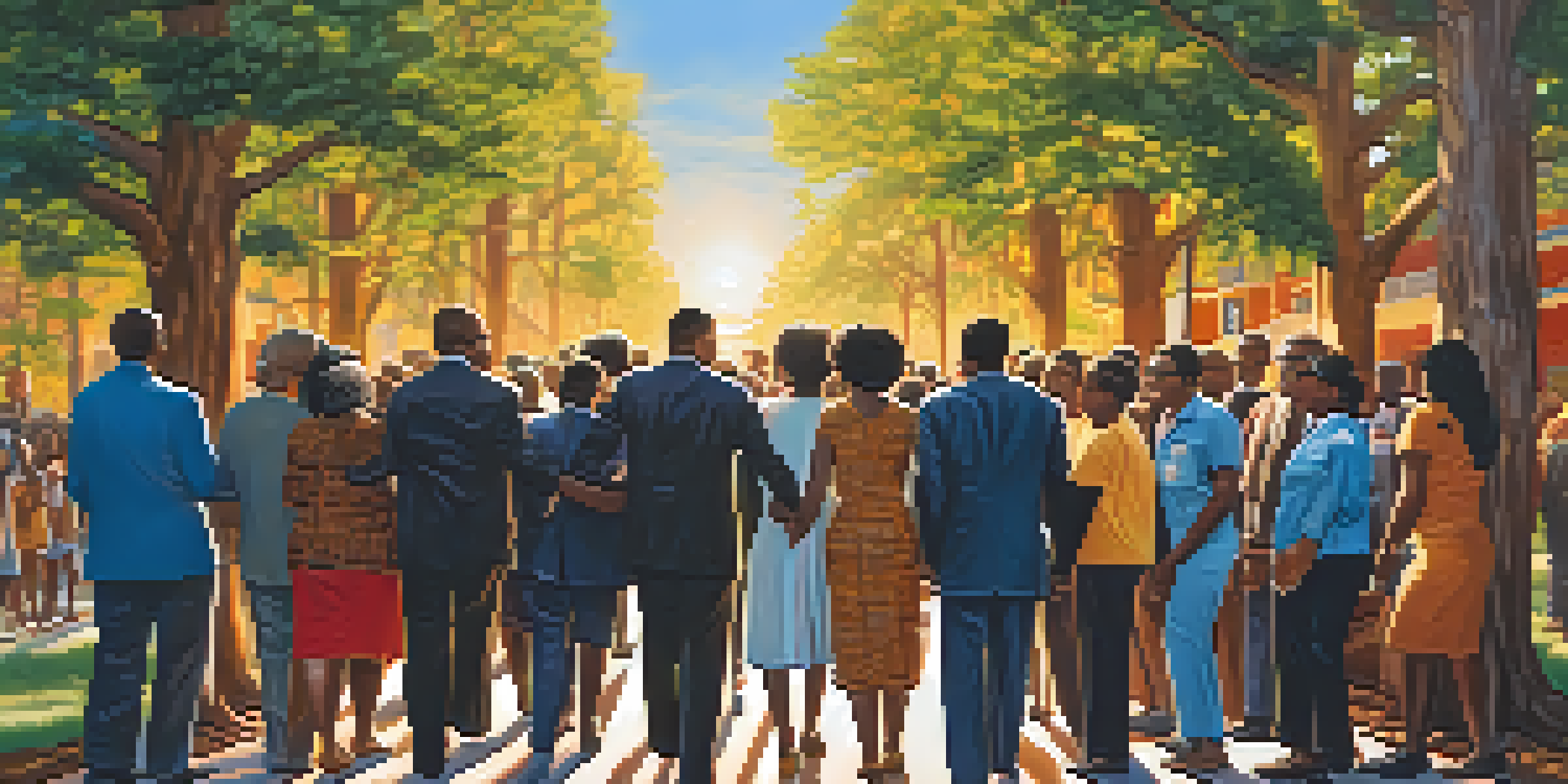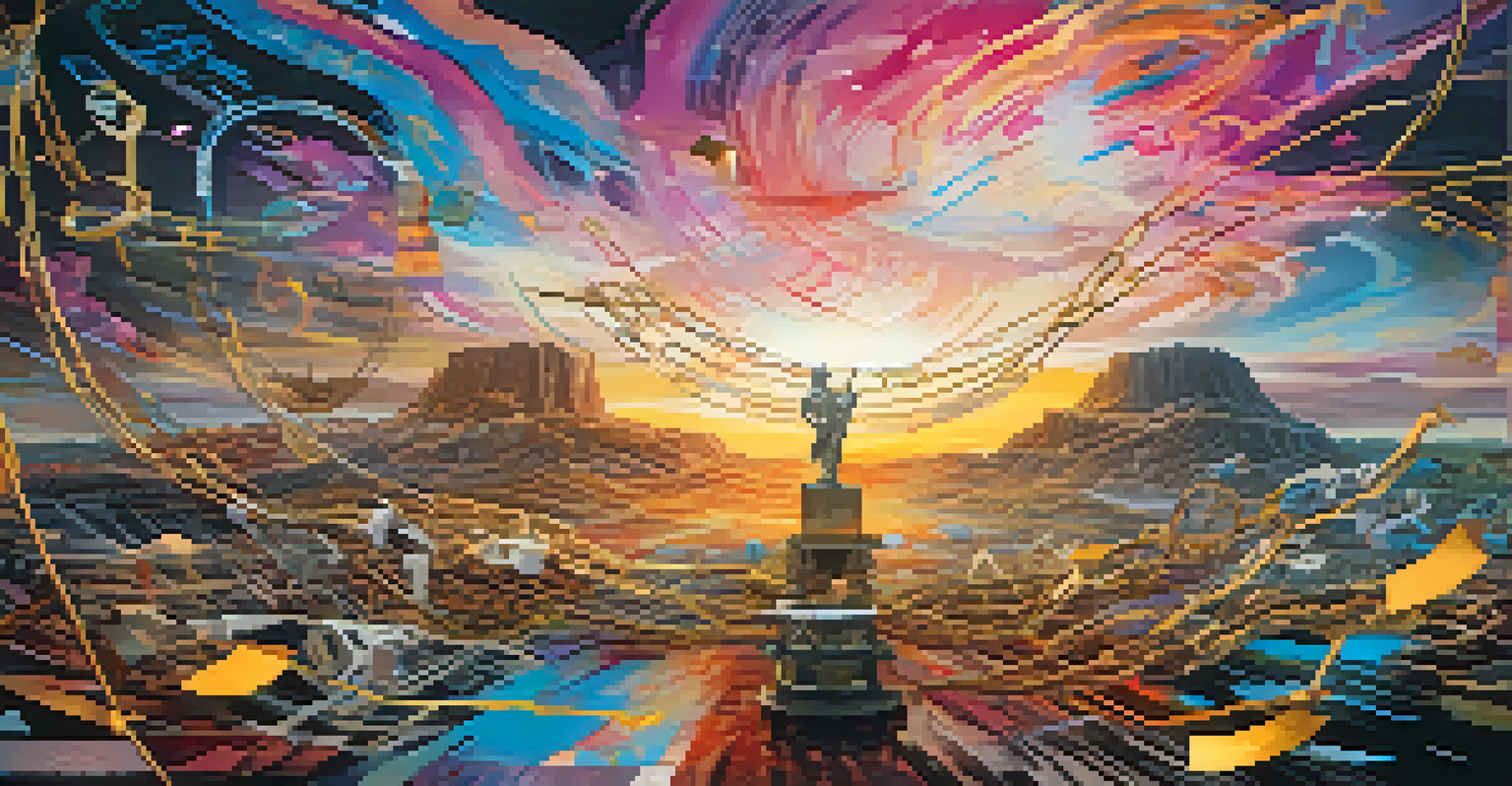Exploring Art as Resistance: Historical Movements and Impact

Understanding Art as a Form of Resistance
Art has long been a powerful medium for expressing dissent and challenging the status quo. From graffiti on city walls to powerful paintings in galleries, artistic expression often reflects the struggles and aspirations of individuals and communities. This concept of art as resistance is rooted in the belief that creativity can provoke thought, inspire change, and unite people against oppression.
Art is not freedom from discipline, but disciplined freedom.
Consider the vibrant murals that emerged during the civil rights movement in the United States. These works not only captured the pain and hope of the era but also served as a rallying point for activists. By bringing visual narratives to public spaces, artists transformed their surroundings into platforms for social commentary and collective memory.
In essence, art becomes a voice for the voiceless, offering a means of communication that transcends language and cultural barriers. It invites us to reflect on our own experiences while connecting us to the broader human story of resistance and resilience.
Historical Movements: Art During the French Revolution
The French Revolution serves as a prime example of how art can embody the spirit of rebellion. Artists like Eugène Delacroix used their work to capture the fervor and ideals of liberty, equality, and fraternity. His painting 'Liberty Leading the People' not only depicts a pivotal moment in the revolution but also symbolizes the struggle for freedom and justice.

Through dramatic imagery and emotive compositions, revolutionary art inspired citizens to rise up against tyranny. It played a crucial role in shaping public opinion and rallying support for the revolutionary cause, demonstrating how art can influence social and political landscapes.
Art as a Voice for Resistance
Art serves as a powerful medium for expressing dissent and uniting communities against oppression.
Moreover, the legacy of these artistic movements continues to resonate today, reminding us of the ongoing fight for human rights and social justice. The power of visual storytelling remains a catalyst for change, encouraging new generations to engage with pressing issues through creative expression.
The Role of Art in the Civil Rights Movement
The Civil Rights Movement in the U.S. saw artists and musicians harnessing the power of their crafts to address systemic racism and injustice. Music, particularly genres like gospel and blues, became anthems for change, while visual artists documented the struggle through powerful imagery. The combination of art and activism created a profound cultural impact that galvanized communities.
The role of the artist is to make the revolution irresistible.
For instance, the photography of Gordon Parks highlighted the harsh realities of life for African Americans, capturing both the beauty and the pain of their experiences. His work not only informed the public but also inspired empathy and action, showcasing how art can serve as a mirror reflecting societal issues.
By intertwining art with activism, the Civil Rights Movement created a legacy that continues to inspire contemporary artists. The lessons learned from this era remind us that art is not just for aesthetic appreciation; it can be a potent tool for social change and collective empowerment.
Art as Resistance in Latin American Political Struggles
In Latin America, art has played a pivotal role in political resistance, particularly during times of dictatorship and repression. Artists like Oswaldo Guayasamín used their work to express the pain of marginalized communities and to highlight the struggles against oppressive regimes. His powerful imagery often depicted themes of suffering and resilience, making a profound statement about the human condition.
Murals in countries like Mexico also became vital expressions of social and political commentary. The Mexican Muralism movement, led by artists such as Diego Rivera and David Alfaro Siqueiros, sought to educate the public about their history and rights. These large-scale works turned public spaces into classrooms, fostering a sense of national identity and collective consciousness.
Historical Significance of Art
Art has historically played a crucial role in movements like the French Revolution and the Civil Rights Movement, inspiring change and shaping public opinion.
Through these artistic movements, Latin American artists have not only resisted oppression but have also reclaimed their narratives. Their work continues to inspire current and future generations to use art as a tool for social justice and political engagement.
The Impact of Digital Art in Modern Activism
In today's digital age, art has found new avenues for expression and resistance. Social media platforms allow artists to share their work instantly, reaching global audiences and fostering community engagement. This democratization of art has empowered individuals to participate in activism from anywhere in the world, illustrating how technology can amplify artistic voices.
For instance, digital artists have created compelling visuals that address issues like climate change, racial injustice, and gender equality. These works often go viral, influencing public discourse and mobilizing support for various causes. The immediacy and accessibility of digital art make it a potent tool for raising awareness and driving change.
As we navigate complex global challenges, the role of digital art in activism will likely continue to grow. It serves as a reminder that creativity can inspire hope, provoke thought, and unite people across borders in the fight for justice.
Art as a Form of Healing and Community Building
Beyond resistance, art also plays a vital role in healing and community building, especially in the aftermath of conflict or oppression. Creative expression allows individuals to process trauma and express their emotions in a safe space. Art therapy, for example, has been shown to help survivors of violence and war reclaim their narratives and find solace in shared experiences.
Community art projects often bring people together, fostering solidarity and collaboration. These initiatives create a sense of belonging and purpose, reminding participants that they are not alone in their struggles. Through collective creativity, communities can heal and rebuild, transforming pain into empowerment.
Digital Art's Role in Activism
In the digital age, art has become more accessible, enabling artists to engage global audiences and advocate for social change through online platforms.
Ultimately, art as a form of healing underscores its multifaceted nature. It not only serves as a tool for resistance but also creates pathways for understanding, compassion, and community resilience.
The Future of Art as Resistance
As we look to the future, the relationship between art and resistance is more critical than ever. With ongoing global issues such as climate change, social inequality, and political unrest, artists are poised to be at the forefront of these movements. Their ability to capture the essence of these struggles through creative expression can influence public perception and inspire action.
Emerging artists are utilizing innovative techniques, from virtual reality to interactive installations, to engage audiences in new ways. This evolution of artistic expression allows for deeper connections and encourages dialogue around pressing issues. The future of art as resistance will likely continue to evolve, reflecting the changing landscape of society.

In conclusion, as we navigate the complexities of our world, we must recognize the invaluable role of art in advocating for change. By supporting artistic expression, we contribute to a legacy of resistance that empowers individuals and communities to envision a better future.